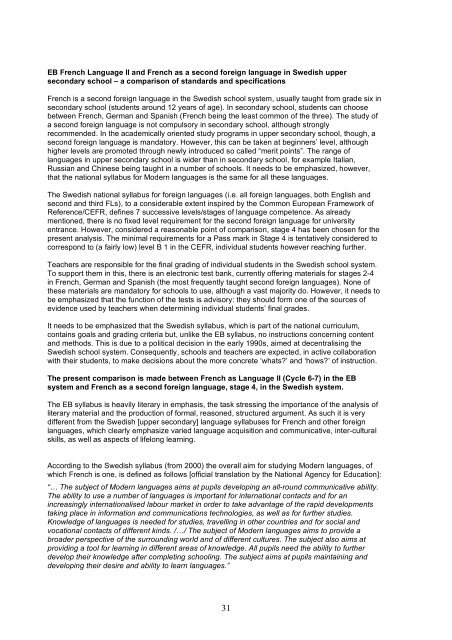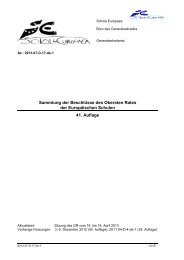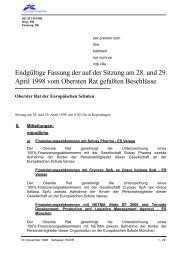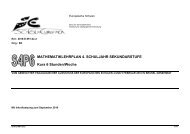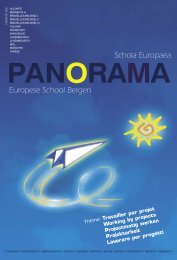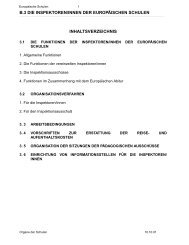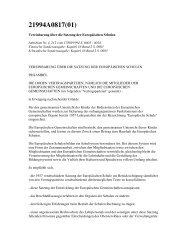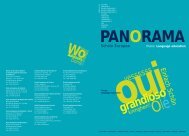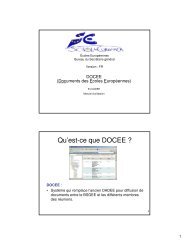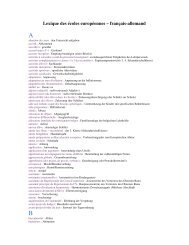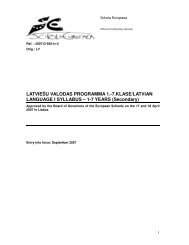External Evaluation of the European Baccalaureate (Annexes)
External Evaluation of the European Baccalaureate (Annexes)
External Evaluation of the European Baccalaureate (Annexes)
Create successful ePaper yourself
Turn your PDF publications into a flip-book with our unique Google optimized e-Paper software.
EB French Language II and French as a second foreign language in Swedish upper<br />
secondary school – a comparison <strong>of</strong> standards and specifications<br />
French is a second foreign language in <strong>the</strong> Swedish school system, usually taught from grade six in<br />
secondary school (students around 12 years <strong>of</strong> age). In secondary school, students can choose<br />
between French, German and Spanish (French being <strong>the</strong> least common <strong>of</strong> <strong>the</strong> three). The study <strong>of</strong><br />
a second foreign language is not compulsory in secondary school, although strongly<br />
recommended. In <strong>the</strong> academically oriented study programs in upper secondary school, though, a<br />
second foreign language is mandatory. However, this can be taken at beginners’ level, although<br />
higher levels are promoted through newly introduced so called “merit points”. The range <strong>of</strong><br />
languages in upper secondary school is wider than in secondary school, for example Italian,<br />
Russian and Chinese being taught in a number <strong>of</strong> schools. It needs to be emphasized, however,<br />
that <strong>the</strong> national syllabus for Modern languages is <strong>the</strong> same for all <strong>the</strong>se languages.<br />
The Swedish national syllabus for foreign languages (i.e. all foreign languages, both English and<br />
second and third FLs), to a considerable extent inspired by <strong>the</strong> Common <strong>European</strong> Framework <strong>of</strong><br />
Reference/CEFR, defines 7 successive levels/stages <strong>of</strong> language competence. As already<br />
mentioned, <strong>the</strong>re is no fixed level requirement for <strong>the</strong> second foreign language for university<br />
entrance. However, considered a reasonable point <strong>of</strong> comparison, stage 4 has been chosen for <strong>the</strong><br />
present analysis. The minimal requirements for a Pass mark in Stage 4 is tentatively considered to<br />
correspond to (a fairly low) level B 1 in <strong>the</strong> CEFR, individual students however reaching fur<strong>the</strong>r.<br />
Teachers are responsible for <strong>the</strong> final grading <strong>of</strong> individual students in <strong>the</strong> Swedish school system.<br />
To support <strong>the</strong>m in this, <strong>the</strong>re is an electronic test bank, currently <strong>of</strong>fering materials for stages 2-4<br />
in French, German and Spanish (<strong>the</strong> most frequently taught second foreign languages). None <strong>of</strong><br />
<strong>the</strong>se materials are mandatory for schools to use, although a vast majority do. However, it needs to<br />
be emphasized that <strong>the</strong> function <strong>of</strong> <strong>the</strong> tests is advisory: <strong>the</strong>y should form one <strong>of</strong> <strong>the</strong> sources <strong>of</strong><br />
evidence used by teachers when determining individual students’ final grades.<br />
It needs to be emphasized that <strong>the</strong> Swedish syllabus, which is part <strong>of</strong> <strong>the</strong> national curriculum,<br />
contains goals and grading criteria but, unlike <strong>the</strong> EB syllabus, no instructions concerning content<br />
and methods. This is due to a political decision in <strong>the</strong> early 1990s, aimed at decentralising <strong>the</strong><br />
Swedish school system. Consequently, schools and teachers are expected, in active collaboration<br />
with <strong>the</strong>ir students, to make decisions about <strong>the</strong> more concrete ‘whats?’ and ‘hows?’ <strong>of</strong> instruction.<br />
The present comparison is made between French as Language II (Cycle 6-7) in <strong>the</strong> EB<br />
system and French as a second foreign language, stage 4, in <strong>the</strong> Swedish system.<br />
The EB syllabus is heavily literary in emphasis, <strong>the</strong> task stressing <strong>the</strong> importance <strong>of</strong> <strong>the</strong> analysis <strong>of</strong><br />
literary material and <strong>the</strong> production <strong>of</strong> formal, reasoned, structured argument. As such it is very<br />
different from <strong>the</strong> Swedish [upper secondary] language syllabuses for French and o<strong>the</strong>r foreign<br />
languages, which clearly emphasize varied language acquisition and communicative, inter-cultural<br />
skills, as well as aspects <strong>of</strong> lifelong learning.<br />
According to <strong>the</strong> Swedish syllabus (from 2000) <strong>the</strong> overall aim for studying Modern languages, <strong>of</strong><br />
which French is one, is defined as follows [<strong>of</strong>ficial translation by <strong>the</strong> National Agency for Education]:<br />
“… The subject <strong>of</strong> Modern languages aims at pupils developing an all-round communicative ability.<br />
The ability to use a number <strong>of</strong> languages is important for international contacts and for an<br />
increasingly internationalised labour market in order to take advantage <strong>of</strong> <strong>the</strong> rapid developments<br />
taking place in information and communications technologies, as well as for fur<strong>the</strong>r studies.<br />
Knowledge <strong>of</strong> languages is needed for studies, travelling in o<strong>the</strong>r countries and for social and<br />
vocational contacts <strong>of</strong> different kinds. /…/ The subject <strong>of</strong> Modern languages aims to provide a<br />
broader perspective <strong>of</strong> <strong>the</strong> surrounding world and <strong>of</strong> different cultures. The subject also aims at<br />
providing a tool for learning in different areas <strong>of</strong> knowledge. All pupils need <strong>the</strong> ability to fur<strong>the</strong>r<br />
develop <strong>the</strong>ir knowledge after completing schooling. The subject aims at pupils maintaining and<br />
developing <strong>the</strong>ir desire and ability to learn languages.”<br />
31


